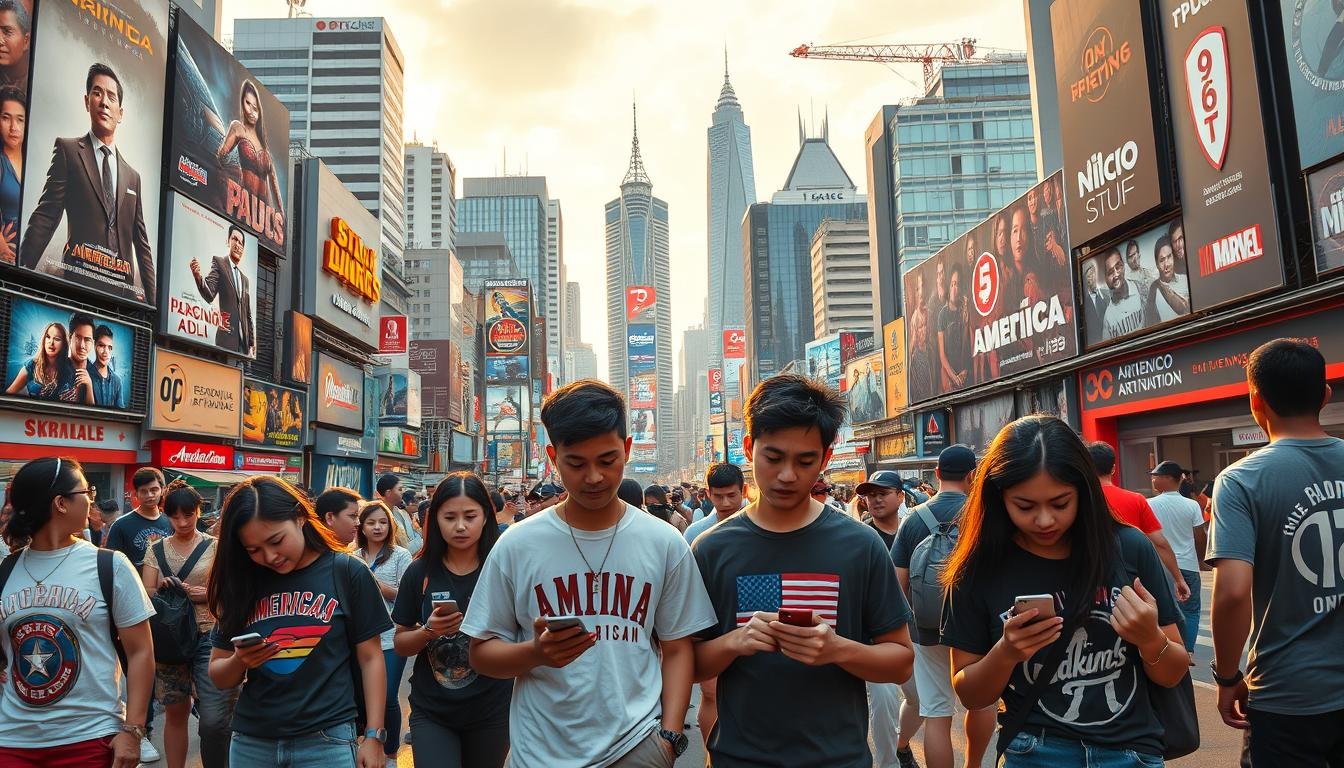American popular culture has deeply influenced Filipino society in many ways. From media and technology to art and traditions, the impact is undeniable. This connection dates back to historical ties and continues to evolve in the modern digital age.
Filipino customs and values have blended with American symbolism and language. For example, American TV shows, music, and fashion are widely embraced. This fusion shapes daily life and social behavior in the Philippines.
Understanding this influence helps us see how global connections shape local practices. It also highlights the importance of media in shaping beliefs and systems. This article explores these aspects in detail.
Key Takeaways
- American popular culture has a strong influence on Filipino society.
- Media and technology play a key role in this cultural exchange.
- Historical ties have shaped modern Filipino customs and values.
- Language and symbolism from the U.S. are widely adopted in the Philippines.
- Understanding this impact helps explain global and local connections.
American Popular Culture and Its Influence on Filipino Society
The global reach of American media has left a lasting mark on Filipino society. From films and music to television shows, these elements shape how Filipinos view the world. They also blend with local traditions, creating a unique cultural mix.
American films and TV series often introduce new ideas and lifestyles. For example, shows like Friends and The Simpsons have become household names. These programs not only entertain but also influence fashion, language, and social behavior.
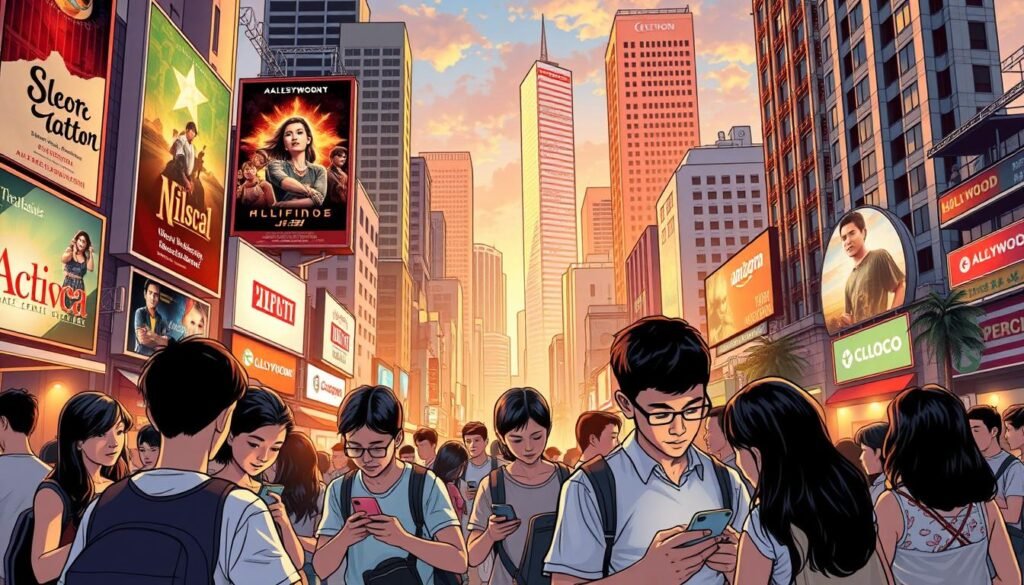
Music is another powerful tool of cultural exchange. American pop and hip-hop dominate local playlists. Artists like Taylor Swift and Drake inspire Filipino musicians, who adapt these styles to their own work.
Language is a key aspect of this influence. English, introduced during the American colonial period, remains widely spoken. Words and phrases from American slang are often used in everyday conversations.
Digital platforms amplify this cultural exchange. Social media connects Filipinos to global trends. Platforms like Instagram and TikTok showcase American fashion, food, and lifestyle, which are quickly adopted locally.
This blend of cultures has both positive and challenging aspects. While it fosters creativity and global awareness, it can also overshadow local traditions. Understanding this balance is crucial for preserving Filipino identity.
| Aspect | Influence |
|---|---|
| Films and TV | Shapes fashion, language, and behavior |
| Music | Inspires local artists and trends |
| Language | Integrates English and American slang |
| Digital Media | Connects Filipinos to global trends |
As we explore this topic further, we’ll delve into the historical roots and modern-day impacts of this cultural exchange. This sets the stage for a deeper understanding of how global and local practices intertwine.
Historical Overview of American Cultural Influence in the Philippines
The historical ties between the U.S. and the Philippines laid the groundwork for a lasting cultural exchange. This relationship began during the colonial era and has evolved over time. Early encounters introduced new systems and values that continue to shape Filipino society today.
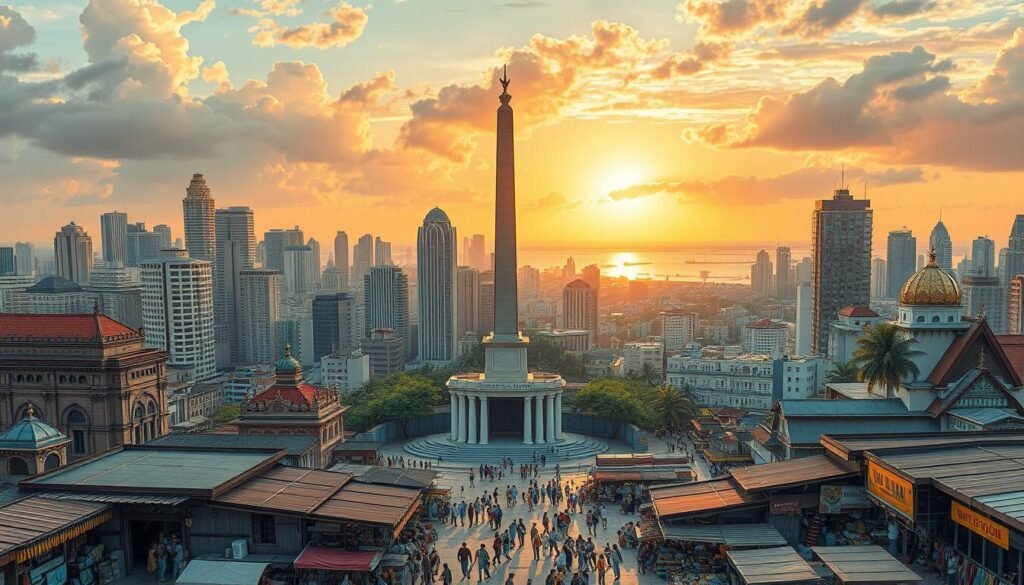
Colonial Legacies and Early Encounters
During the American colonial period, significant changes were introduced. The public education system made English the medium of instruction. This decision had a profound impact on language and communication in the Philippines.
By the 1930s, nearly 50% of the population was literate, and 25% could speak English. These changes fostered a middle class of educated Filipinos. They became key contributors to the nation’s development.
Another legacy was the introduction of democratic ideals. The Jones Act of 1916 aimed to prepare the Philippines for independence. This laid the foundation for the country’s political system.
Post-Colonial Cultural Shifts
After gaining independence, the Philippines continued to embrace American influences. The Tydings-McDuffie Act established a 10-year commonwealth period. This allowed for further cultural exchange and collaboration.
Post-colonial shifts included the rise of English literature. Works like Paz Marquez Benitez’s Dead Stars marked a milestone in Filipino writing. This period also saw the emergence of modernist poetry and popular fiction.
Today, these historical influences remain evident. American values and systems are deeply embedded in Filipino institutions. Understanding this history helps explain the country’s unique blend of traditions and modernity.
| Period | Key Influence |
|---|---|
| Colonial Era | Introduction of English and public education |
| Post-Colonial | Rise of English literature and democratic ideals |
| Modern Day | Continued integration of American values |
Evolution of Filipino Traditions in Modern Times
Filipino traditions have undergone significant changes in recent decades, blending historical roots with modern influences. This evolution reflects a dynamic interplay between preserving heritage and embracing innovation. American influences have played a key role in reshaping these customs, creating a unique fusion of old and new.
One example is the transformation of traditional celebrations. Festivals like Sinulog and Pahiyas now incorporate Western elements, such as modern music and dance styles. This blend keeps traditions alive while appealing to younger generations.
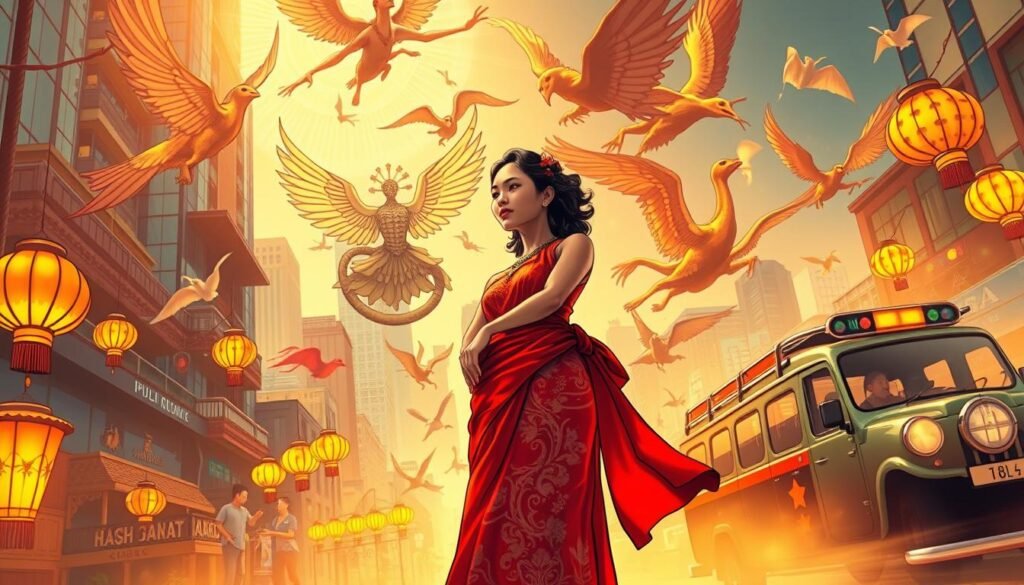
Media and technology have also fostered evolving cultural expressions. Social platforms like TikTok and Instagram showcase Filipino traditions to a global audience. This exposure encourages creativity and adaptation, ensuring traditions remain relevant in a connected world.
Societal practices and belief systems have adapted to modernity as well. For instance, the value of family remains central, but its expression has evolved. Modern Filipino families often balance traditional roles with contemporary lifestyles, reflecting broader societal changes.
“The beauty of Filipino traditions lies in their ability to adapt while staying true to their roots.”
This ongoing transformation highlights the resilience of Filipino customs. By blending historical practices with modern influences, traditions continue to thrive in a rapidly changing world. Understanding this balance is essential for preserving cultural identity while embracing progress.
American Media’s Role in Shaping Filipino Identity
American media has become a cornerstone in shaping Filipino identity. From television shows to digital platforms, it influences how Filipinos see themselves and the world. This impact is evident in daily life, from language to social behavior.
Television and Film Influence
American TV shows and films have left a lasting mark on Filipino society. Iconic programs like Friends and The Simpsons are household names. These shows introduce new ideas, fashion trends, and ways of thinking.
Characters and storylines often shape aspirations. For example, the portrayal of strong, independent women in American dramas inspires many Filipinas. This influence extends to language, with English phrases and slang becoming part of everyday conversations.
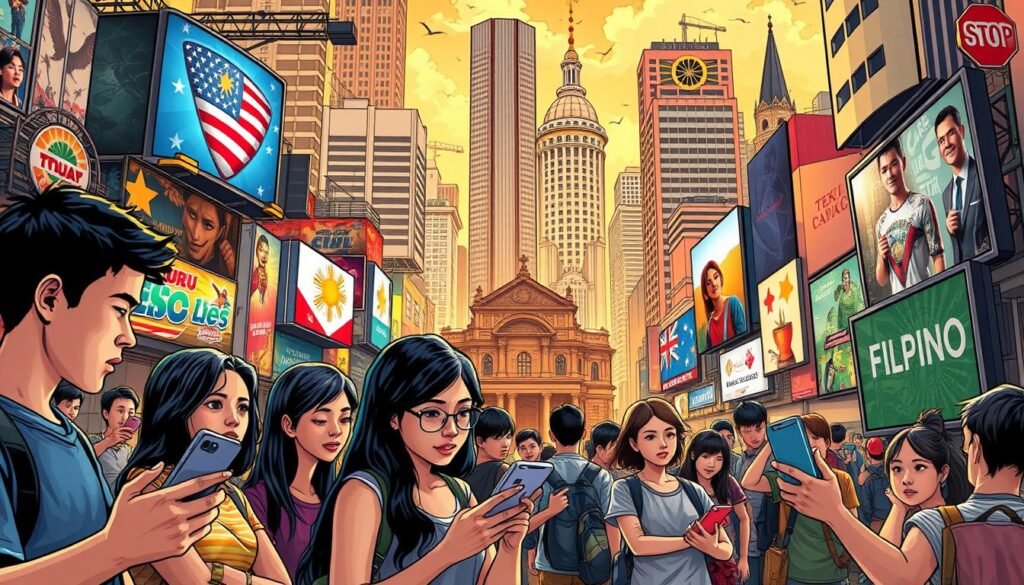
Digital Media and Social Platforms
The rise of digital media has accelerated cultural exchange. Platforms like Instagram and TikTok showcase American trends, which are quickly adopted in the Philippines. These platforms also allow Filipinos to share their own stories with the world.
Social media fosters online communities where cultural exchange thrives. For instance, Filipino creators blend local traditions with global trends, creating unique content. This dynamic interaction reshapes notions of art, language, and societal values.
“American media not only entertains but also redefines how Filipinos perceive their identity.”
| Aspect | Impact |
|---|---|
| Television | Shapes fashion, language, and aspirations |
| Film | Introduces new ideas and lifestyles |
| Digital Media | Facilitates global cultural exchange |
Understanding this influence helps explain the evolving Filipino identity. It highlights the power of media in shaping beliefs and behaviors. For more insights on historical influences, visit this resource.
Impact on Everyday Filipino Life and Lifestyle
The daily lives of Filipinos reflect a blend of local traditions and global influences, shaped by years of cultural exchange. American society has left a lasting mark on how Filipinos dress, work, and interact. This fusion is evident in various aspects of life, from fashion to family dynamics.
Fashion trends in the Philippines often mirror those in the U.S. For example, streetwear and casual styles popularized by American brands are widely embraced. This influence extends to workplaces, where business attire often follows Western norms.
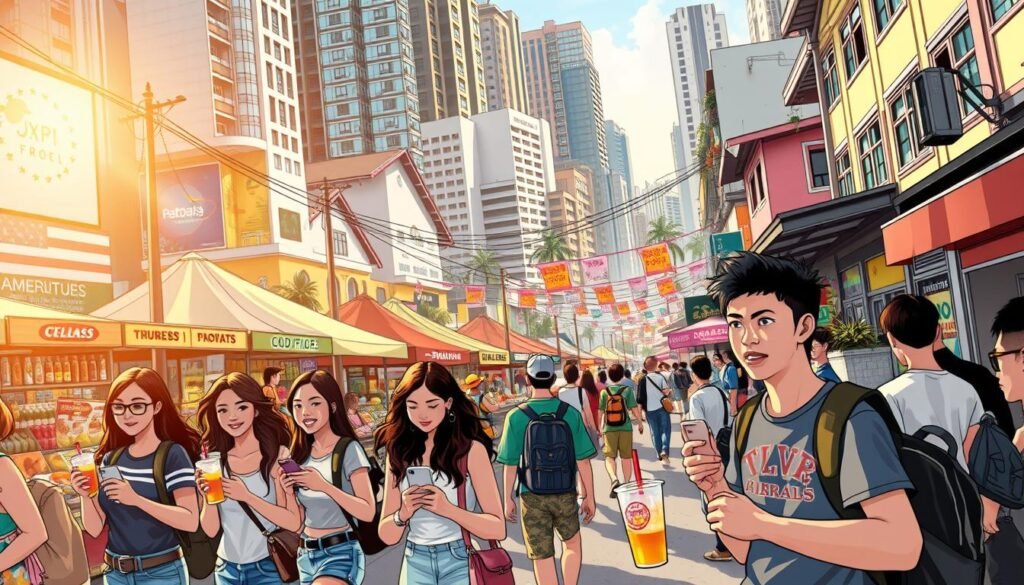
Social etiquette has also evolved. Greetings like handshakes and casual conversations in English are common. These changes reflect a broader shift in behavior, blending traditional Filipino respect with modern practices.
Food consumption patterns highlight this cultural mix. Fast food chains like McDonald’s and KFC are staples in urban areas. Yet, traditional dishes like lechon and adobo remain central to family gatherings, showcasing a balance between old and new.
Leisure activities have transformed as well. Social media platforms like TikTok and Instagram dominate free time. These platforms not only entertain but also introduce global trends, which Filipinos quickly adopt and adapt.
Family dynamics have shifted too. Dual-income households are now common, reflecting changing gender roles. Despite this, the value of family unity remains strong, with regular gatherings and extended family support systems.
“The blending of traditions and modern influences creates a unique Filipino identity, rooted in history yet open to change.”
This hybrid identity is a testament to the resilience of Filipino tradition. It shows how global influences can coexist with local values, shaping a society that is both modern and deeply rooted in its heritage.
American Music, Art, and Entertainment Trends
American music, art, and entertainment have become a driving force in shaping global creative trends, including those in the Philippines. This influence is evident in the way local talent adapts and innovates, blending Western styles with traditional Filipino expressions. From chart-topping hits to viral dance trends, the impact is undeniable.
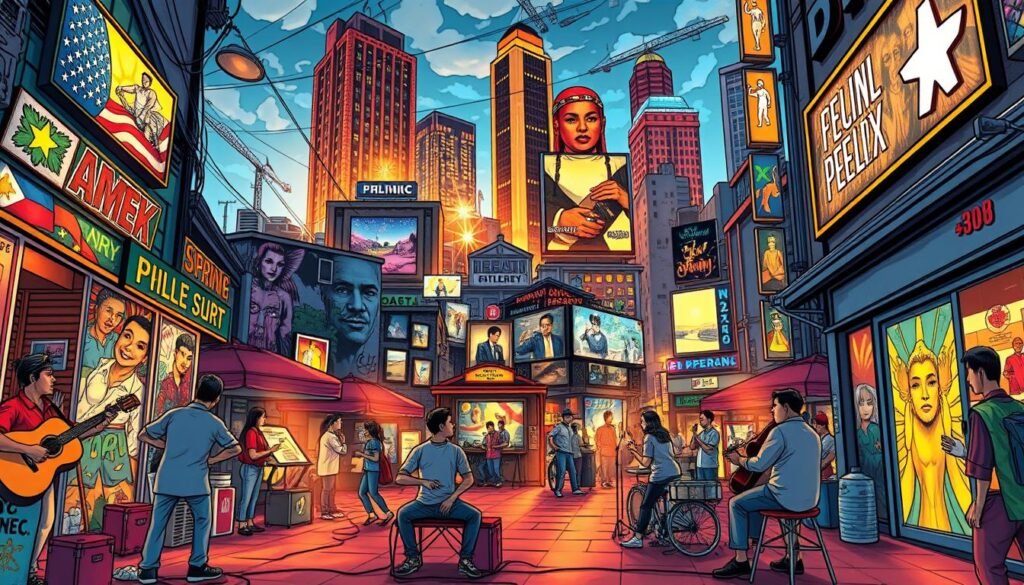
Music genres like pop, hip-hop, and rock dominate Filipino playlists. Artists like Taylor Swift and Bruno Mars inspire local musicians to create their own unique sounds. This exchange has led to the rise of Filipino artists who seamlessly blend international and indigenous styles.
Art and entertainment have also seen significant changes. Western art forms, such as street art and digital media, are integrated into local creative practices. For example, Filipino muralists incorporate American graffiti techniques while showcasing Filipino themes. This fusion enriches the country’s artistic landscape.
Celebrity culture plays a key role in introducing new trends. Hollywood stars and influencers shape fashion, beauty, and lifestyle choices in the Philippines. Social media platforms amplify this effect, making global trends accessible to local audiences.
Cross-cultural collaborations highlight the merger of entertainment trends. Filipino filmmakers and musicians often partner with international counterparts, creating works that resonate globally. These partnerships showcase the Philippines’ creative potential on the world stage.
| Aspect | Impact |
|---|---|
| Music | Blends international and local styles |
| Art | Integrates Western techniques with Filipino themes |
| Entertainment | Celebrity culture shapes trends |
| Collaborations | Showcases Filipino talent globally |
The influence of American music, art, and entertainment extends beyond creative industries. It fosters a sense of global connection while encouraging Filipinos to celebrate their unique identity. This dynamic exchange continues to shape the country’s cultural evolution.
Culture
The concept of culture encompasses both material and immaterial aspects of society. It includes everything from art and language to beliefs and social practices. This complex interplay shapes how groups and individuals interact, creating a shared way of life.
One key aspect of culture is its ability to evolve over time. Through practices like storytelling and education, cultural elements are passed down from one generation to the next. This transmission ensures that traditions and values remain relevant in a changing world.
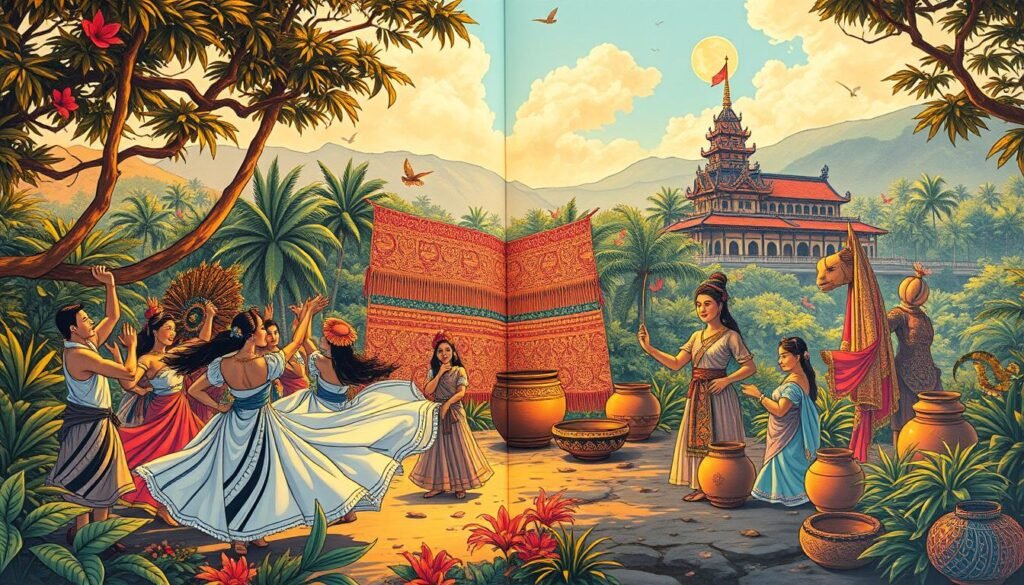
Anthropologists often distinguish between high culture and folk or popular culture. High culture is typically associated with elites, while folk culture reflects the everyday practices of ordinary people. Both forms play a vital role in shaping societal identity.
“Culture is not just a set of practices; it’s a living system that adapts and grows with each generation.”
Debates around cultural relativism versus universalist approaches highlight the diversity of human experiences. Cultural relativism argues that practices should be understood within their own context, while universalism seeks common values across societies.
Understanding these debates helps frame the study of social phenomena. It also emphasizes the importance of respecting diverse cultural practices while recognizing shared human values.
| Aspect | Description |
|---|---|
| Material Culture | Physical objects like art, tools, and buildings |
| Immaterial Culture | Beliefs, values, and social practices |
| High Culture | Associated with elites and formal institutions |
| Folk Culture | Everyday practices of ordinary people |
Culture is a dynamic system that continues to evolve. By studying its elements and transmission, we gain a deeper understanding of how societies function and adapt. This knowledge is essential for fostering mutual respect and global cooperation.
Social Behavior: Customs, Respect, and Group Dynamics
Social behavior in the Philippines is deeply rooted in customs and respect, shaping group dynamics in unique ways. These elements define how individuals interact within their communities, blending traditional practices with modern influences. Understanding these norms provides insight into Filipino society and its values.
Customs and manners play a central role in Filipino social interactions. For example, gestures like pagmamano (blessing by touching an elder’s hand to one’s forehead) reflect deep respect for elders. These practices are not just formalities but integral parts of daily life, fostering harmony and cohesion.
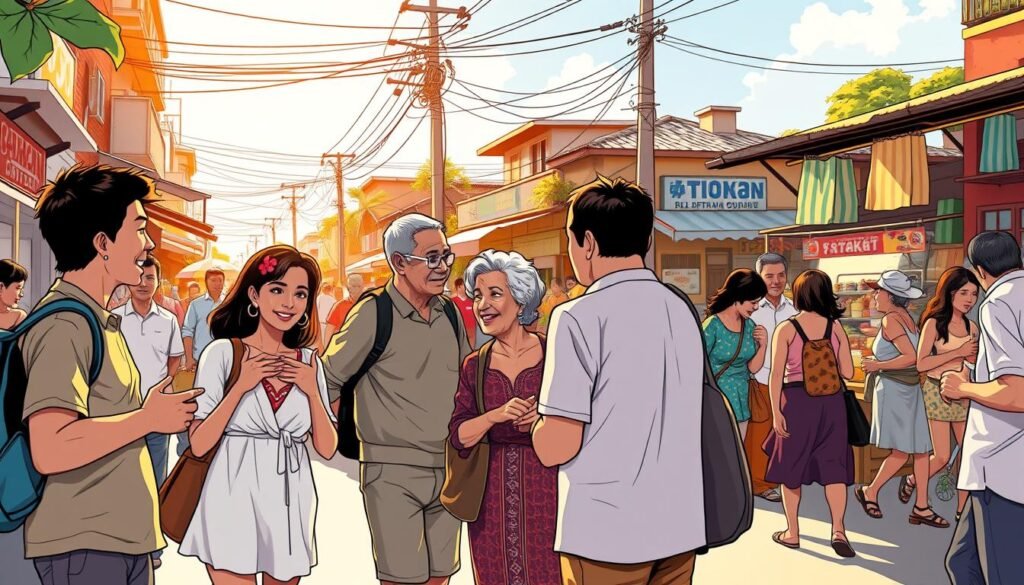
Respect is a cornerstone of Filipino group dynamics. It influences how individuals address one another, often using honorifics like po and opo to show deference. This emphasis on respect strengthens interpersonal relationships, creating a sense of unity within groups.
Traditional practices have evolved to adapt to modern contexts. Festivals like Sinulog and Pahiyas now incorporate contemporary elements while retaining their cultural essence. This blend ensures that traditions remain relevant, appealing to younger generations.
Group dynamics are shaped by both indigenous values and external influences. For instance, the concept of bayanihan (community cooperation) remains a vital part of Filipino practice. At the same time, global trends introduced through media and technology have redefined social norms.
“Respect and customs are the threads that weave the fabric of Filipino social behavior, creating a harmonious and cohesive community.”
Societal expectations dictate behavioral norms, emphasizing the importance of community and ritual. These expectations ensure that individuals prioritize group welfare over personal interests, fostering a collective mindset.
| Aspect | Influence |
|---|---|
| Customs | Define social interactions and manners |
| Respect | Shapes group dynamics and relationships |
| Traditional Practices | Adapt to modern contexts while retaining cultural essence |
| Group Dynamics | Influenced by indigenous values and external forces |
| Societal Expectations | Dictate behavioral norms and social order |
Understanding these elements highlights the resilience of Filipino social behavior. It shows how traditions and modern influences coexist, shaping a society that values respect, unity, and community.
Language and Communication in a Changing Society
Language and communication play a pivotal role in shaping cultural identity, especially in a society like the Philippines. The way people speak, write, and interact reflects their values, traditions, and social norms. In a world increasingly connected by technology, language evolves rapidly, blending local and global influences.
American English has become a significant part of Filipino communication. Introduced during the colonial period, it remains widely used in education, media, and daily life. Words and phrases from American slang are often integrated into Filipino conversations, creating a unique linguistic blend.
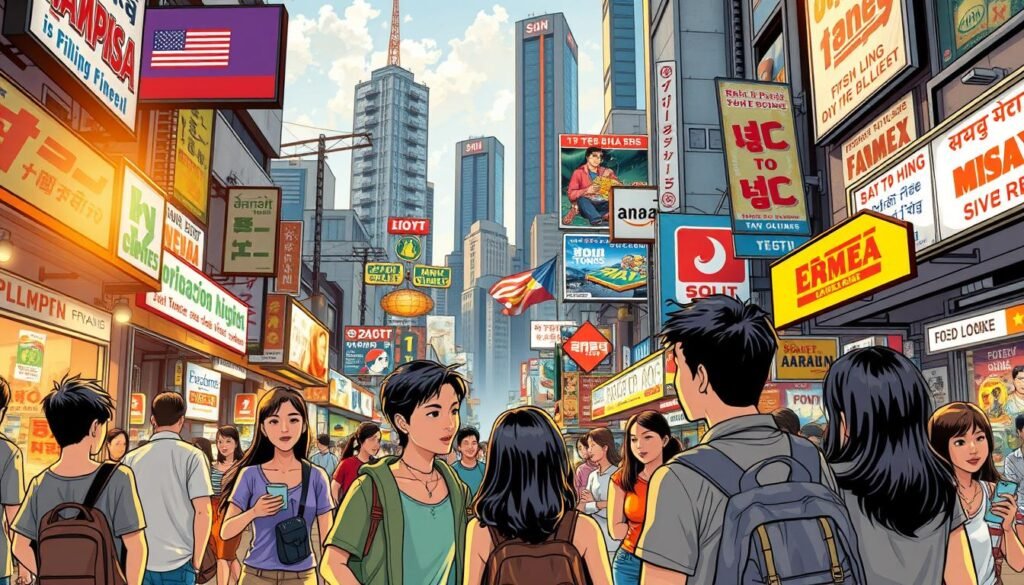
Articulate speech and symbolic behavior are essential for cultural transmission. For example, gestures like pagmamano (blessing by touching an elder’s hand to one’s forehead) convey respect and tradition. These practices ensure that cultural values are passed down through generations.
Code-switching and bilingualism are common in the Philippines. Many Filipinos seamlessly switch between English and their native languages, depending on the context. This reflects the dynamic interplay between local and global influences, shaping a unique cultural identity.
“Language is not just a tool for communication; it’s a bridge that connects people to their heritage and the world.”
Digital communication has further reshaped language and social interactions. Platforms like Facebook and TikTok introduce new trends and expressions, which are quickly adopted locally. This constant exchange keeps Filipino language and culture vibrant and adaptable.
Understanding the role of language in society helps us appreciate its power to unite and transform. For more insights on this topic, explore language and cultural context.
Education and University Influence on Cultural Exchange
Education plays a vital role in bridging cultural gaps, fostering understanding, and shaping global perspectives. Universities, in particular, serve as hubs for cultural exchange, where students and faculty from diverse backgrounds come together. This interaction creates a unique environment for learning and growth.
Academic research and programs often integrate American cultural perspectives with local traditions. For example, universities in the Philippines offer courses that explore both Filipino heritage and global influences. This blend helps students develop a well-rounded view of the world.
International collaborations further enhance this exchange. Partnerships between Filipino and American universities allow for cross-cultural curricula and joint research projects. These initiatives not only enrich academic experiences but also promote mutual understanding.
Community-based projects are another significant aspect of higher education. Universities often lead initiatives that engage local communities, preserving traditions while introducing new ideas. For instance, cultural festivals and workshops bring together students and residents, fostering a sense of unity.
“Education is the most powerful tool we can use to change the world.”
Cultural studies programs also play a key role. These programs encourage students to explore the complexities of cultural identity and global interconnectedness. By studying both Filipino and American elements, students gain a deeper appreciation for diversity.
Universities are not just centers of learning; they are catalysts for change. Through education, they preserve traditions while embracing global innovations. This balance ensures that cultural heritage remains relevant in a rapidly changing world.
| Initiative | Impact |
|---|---|
| Cross-Cultural Courses | Blend local and global perspectives |
| International Collaborations | Promote mutual understanding |
| Community Projects | Engage and unite local residents |
| Cultural Studies Programs | Explore identity and diversity |
Education remains a powerful medium for cultural preservation and exchange. By fostering understanding and collaboration, universities help shape a more connected and inclusive society.
Culinary Traditions: Fusion of Flavors and Foods
Filipino cuisine has embraced a unique blend of flavors, merging traditional recipes with modern influences. This fusion reflects the country’s rich history of cultural exchange. American food trends, in particular, have woven their way into Filipino kitchens, creating dishes that are both familiar and innovative.
Fusion cuisine symbolizes the blending of Western ingredients with indigenous recipes. For example, dishes like adobo burgers and lechon tacos combine Filipino staples with American fast-food culture. These creations highlight the adaptability of Filipino culinary traditions.
Social media and television play a significant role in popularizing fusion food trends. Platforms like Instagram and TikTok showcase creative recipes, inspiring home cooks to experiment. Cooking shows also introduce new techniques, making fusion cuisine accessible to a wider audience.
Culinary innovation is part of broader cultural change. As lifestyles evolve, so do dining customs. Restaurants offering fusion dishes attract diverse clientele, reflecting the Philippines’ openness to global influences. This trend also emphasizes the importance of food as a symbol of cultural identity.
“Food is more than sustenance; it’s a celebration of heritage and creativity.”
Examples of popular fusion dishes include halo-halo cheesecake and sinigang ramen. These dishes not only delight the palate but also tell a story of cultural integration. They showcase how Filipino chefs and home cooks reinterpret traditional recipes with a modern twist.
For more insights on the evolution of fusion cuisine, explore this resource. It highlights how fusion dishes continue to shape global culinary landscapes.
Food remains a powerful element of cultural identity. It connects people to their roots while embracing new ideas. In the Philippines, the fusion of flavors is a testament to the country’s dynamic and evolving society.
Religion and Belief: Syncretism and Shifting Values
Religious practices in the Philippines showcase a fascinating blend of traditional beliefs and modern influences. This syncretism reflects the country’s ability to adapt while preserving its spiritual roots. Over time, American religious ideas have intertwined with local practices, creating a unique spiritual landscape.
One notable example is the integration of Christian rituals with indigenous customs. Festivals like Pahiyas and Sinulog combine Catholic traditions with pre-colonial elements. This fusion highlights the Philippines’ rich history of cultural exchange and adaptation.
Media and pop culture have also played a role in reshaping perceptions of religion. Television shows and social media often introduce new interpretations of faith, blending global trends with local values. This has led to a dynamic evolution of spiritual practices in the modern era.
However, this blending of traditions is not without tension. Some communities strive to maintain their sacred practices, resisting modern reinterpretations. This balance between old and new is a key aspect of the Philippines’ evolving belief systems.
“Syncretism is not just a blending of traditions; it’s a testament to the resilience of faith in a changing world.”
Community and familial traditions play a vital role in sustaining these evolving beliefs. Rituals passed down through generations ensure that spiritual values remain relevant. This collective effort strengthens the bond between individuals and their shared heritage.
Understanding this syncretism helps explain the Philippines’ unique approach to religion. It shows how global influences can coexist with local traditions, shaping a society that values both innovation and continuity.
| Aspect | Impact |
|---|---|
| Christian Rituals | Blend with indigenous customs |
| Media Influence | Reshapes perceptions of faith |
| Community Traditions | Sustain evolving belief systems |
| Historical Shifts | Create hybrid spiritual models |
This dynamic interplay between tradition and modernity continues to shape Filipino spirituality. It highlights the importance of preserving cultural identity while embracing change.
Cultural Activities and Community Engagement
Community-driven cultural activities in the Philippines foster unity and creativity while preserving heritage. These events bring people together, creating a shared sense of identity and purpose. From vibrant festivals to local arts projects, they highlight the richness of Filipino traditions.
Festivals like Sinulog and Pahiyas are prime examples of cultural engagement. These events blend traditional practices with modern elements, appealing to all generations. They serve as platforms for exchanging ideas and celebrating shared values.
Local organizations play a crucial role in sustaining these activities. Nonprofits and community groups often lead initiatives that preserve cultural heritage. Their efforts ensure that traditions remain relevant in a rapidly changing world.
“Cultural activities are not just events; they are bridges that connect the past, present, and future.”
Public events also encourage intergenerational dialogue. They provide opportunities for older generations to share their knowledge with younger members. This exchange strengthens community bonds and fosters mutual respect.
For more insights on how cultural participation impacts mental health, explore this study. It highlights the importance of tailored interventions in enhancing community engagement.
These activities are more than just celebrations; they are investments in the community. They build social capital, promote inclusivity, and inspire creativity. By participating, individuals contribute to a dynamic and resilient society.
In a world of constant change, cultural activities remind us of our roots. They offer a way to honor the past while embracing the future. This balance is essential for preserving the Philippines’ unique identity.
Theories and Perspectives on Cultural Change
Understanding cultural change requires exploring key theories that explain how societies evolve and adapt. These frameworks help us analyze the ways in which traditions, beliefs, and practices transform over time. By examining concepts like cultural relativism, diffusion, and acculturation, we gain a deeper understanding of global and local dynamics.
Cultural Relativism and the Debate on Higher vs. Low Culture
Cultural relativism argues that all cultural practices should be understood within their own context, without imposing external judgments. This perspective challenges the idea of a hierarchy between “high” and “low” culture. For example, traditional folk art is seen as equally valuable as classical art forms, reflecting the diversity of human expression.
This approach fosters respect for diverse worldviews, promoting inclusivity. However, it also sparks debates about universal values versus cultural uniqueness. By embracing cultural relativism, we can appreciate the richness of different traditions while recognizing shared human experiences.
Diffusion, Acculturation, and Modern Models
Diffusion theory explains how ideas, practices, and innovations spread across societies. For instance, the global popularity of American fast food demonstrates how cultural elements travel and adapt. This process often leads to a blending of traditions, creating new forms of expression.
Acculturation models describe how individuals and groups integrate aspects of another culture into their own. In the Philippines, the fusion of indigenous practices with American influences is a prime example. This blending shapes everything from language to social behavior, reflecting the dynamic nature of cultural change.
“Cultural change is not just a process; it’s a reflection of how societies adapt and grow.”
Modern models of cultural change emphasize the role of technology and globalization. Social media, for instance, accelerates the spread of ideas, enabling rapid adaptation. These tools also allow communities to preserve their heritage while embracing innovation.
| Theory | Key Concept | Impact |
|---|---|---|
| Cultural Relativism | Understanding practices within their context | Promotes respect for diversity |
| Diffusion Theory | Spread of ideas and practices | Encourages cultural blending |
| Acculturation Models | Integration of cultural elements | Shapes identity and traditions |
These theories provide valuable insights into the ongoing evolution of societies. For a deeper dive into theoretical perspectives on culture, explore this resource. Understanding these frameworks helps us navigate the complexities of cultural change in a connected world.
Preserving Identity: Challenges and Opportunities
In a rapidly globalizing world, preserving cultural identity has become both a challenge and an opportunity for Filipino society. The influx of global influences, particularly from the U.S., has reshaped many aspects of daily life. While this exchange fosters creativity and innovation, it also poses risks to indigenous traditions and values.
One of the primary challenges is cultural homogenization. As global brands and media dominate, there is a growing concern about the loss of unique local practices. For example, traditional festivals and rituals may be overshadowed by Western holidays and celebrations. This shift can dilute the rich heritage that defines Filipino society.
However, opportunities for cultural revitalization exist. Education plays a crucial role in raising awareness about the importance of heritage. Schools and universities can integrate local history and traditions into their curricula, ensuring that younger generations understand their roots. Technology also offers innovative ways to preserve and share cultural practices, from digital archives to social media campaigns.
Community activism is another powerful tool. Local organizations and grassroots movements can lead initiatives that celebrate and protect traditions. For instance, efforts to revive endangered languages or promote indigenous art forms demonstrate the resilience of Filipino culture.
“Preserving cultural identity is not about resisting change but finding ways to adapt while staying true to our roots.”
Governmental and non-governmental organizations, such as UNESCO, have also taken steps to safeguard cultural heritage. Programs that document and protect intangible traditions, like oral storytelling and traditional crafts, ensure that these practices endure. Collaborative efforts between local communities and global institutions highlight the importance of shared responsibility in cultural preservation.
Examples of successful initiatives include the digitization of historical records and the promotion of cultural tourism. These strategies not only preserve traditions but also create economic opportunities. By balancing modernization with heritage, Filipino society can thrive in a globalized world.
For businesses and organizations, maintaining cultural identity is essential for fostering deeper connections with diverse audiences. Incorporating cultural themes into branding and storytelling can enhance authenticity and loyalty.
Ultimately, the key lies in finding a balance. Embracing global influences while preserving local traditions ensures that Filipino identity remains vibrant and relevant. This dynamic approach celebrates the past while paving the way for a culturally rich future.
Conclusion
The fusion of American and Filipino elements has reshaped the Philippines in profound ways. From media and education to daily life, this blend has created a unique identity that honors tradition while embracing modernity. Historical ties laid the foundation, but modern adaptations continue to redefine the society.
This cultural exchange has brought both opportunities and challenges. While it fosters creativity and global awareness, it also raises questions about preserving local heritage. The balance between old and new remains a key focus for the Philippines.
Looking ahead, the future of this exchange will depend on critical analysis and thoughtful adaptation. By valuing both global influences and indigenous practices, the Philippines can maintain its unique identity in an interconnected world. For deeper insights into this historical evolution, explore this resource.
Ultimately, the dynamic interplay between cultures highlights the resilience and adaptability of Filipino society. It’s a testament to the power of shared values and mutual respect in shaping a vibrant future.
FAQ
How has American popular culture influenced Filipino society?
American popular culture has significantly shaped Filipino society through media, music, and entertainment. This influence is evident in lifestyle, fashion, and even language, blending global trends with local traditions.
What historical events contributed to American cultural influence in the Philippines?
The American colonial period and post-colonial interactions introduced Western ideas, education systems, and media. These events laid the foundation for ongoing cultural exchange and adaptation.
How has Filipino tradition evolved in modern times?
Filipino traditions have adapted to global influences while retaining core values. Practices like family gatherings and religious festivals now incorporate modern elements, reflecting a balance between old and new.
What role does American media play in shaping Filipino identity?
American media, including television, film, and digital platforms, has influenced Filipino identity by introducing new ideas, lifestyles, and perspectives. This has led to a fusion of global and local cultural elements.
How does American music and art impact Filipino entertainment trends?
American music and art have inspired Filipino artists, leading to the creation of hybrid styles. This cross-cultural exchange enriches the local entertainment scene while maintaining unique Filipino flavors.
How has American influence affected Filipino social behavior and customs?
American influence has introduced new social norms and practices, such as individualism and casual communication styles. However, Filipinos continue to value respect, family, and community in their interactions.
What changes have occurred in Filipino language and communication?
The integration of English and American slang into Filipino language reflects cultural blending. This has made communication more versatile, especially in urban areas and among younger generations.
How do universities in the Philippines contribute to cultural exchange?
Universities serve as hubs for cultural exchange by promoting international programs, research, and collaborations. They encourage students to explore global perspectives while appreciating their heritage.
How has Filipino cuisine been influenced by American food trends?
Filipino cuisine has embraced American food trends, resulting in fusion dishes like burgers with local flavors. This blending highlights the adaptability of Filipino culinary traditions.
What role does religion play in shaping Filipino values amidst cultural changes?
Religion remains a cornerstone of Filipino identity, providing stability amid cultural shifts. While modern influences introduce new ideas, faith continues to guide values and community life.
How do cultural activities strengthen community engagement in the Philippines?
Cultural activities like festivals and art exhibits bring people together, fostering unity and pride. These events celebrate shared heritage while embracing contemporary influences.
What theories explain cultural change in the Philippines?
Theories like cultural relativism and acculturation help explain how Filipino society adapts to global influences. These models highlight the dynamic nature of cultural evolution.
What challenges do Filipinos face in preserving their cultural identity?
Filipinos face challenges like globalization and modernization, which can dilute traditional practices. However, efforts to promote heritage through education and media help maintain cultural pride.
Source Links
- The Impact of Shifts in American Culture
- Examining popular culture and society
- Television’s Impact on American Society and Culture
- Philippines – Culture, Diversity, Traditions | Britannica
- A Study of Popular Culture and its Impact on Youth’s Cultural Identity
- Philippines – US Influence, Colonialism, Revolution | Britannica
- Philippine Literature during the American Period – National Commission for Culture and the Arts
- Filipino Americans: Blending Cultures, Redefining Race
- From Indigenous Roots to Global Fusion: The Evolution of Filipino Culture and Its Impact on Today’s Workforce
- Culture of the Philippines
- Colonial Legacies: Spanish, American, and Japanese Influences on Filipino Culture and the Modern Employee
- How Does Media Influence Social Norms? A Field Experiment on the Role of Common Knowledge.
- Celebrating #MyFilAmStory: 6 Fil-Ams who embrace their roots, heritage
- Bridging Cultures: How Overseas Filipinos Shape the Philippines
- Culture Clash: Traditional Values and Modern Challenges in Filipino Families
- The Philippines: Culture and Tradition – Globalization Partners International
- Popular art – Music Genres, Culture, Trends | Britannica
- Music of the United States
- Arts & Cultural Sector Hit All-Time High in 2022 Value Added to U.S. Economy
- Culture
- Culture | Definition, Characteristics, Examples, Types, Tradition, & Facts | Britannica
- Culture and Social Development | Encyclopedia on Early Childhood Development
- The Influence of Social Group Dynamics on Cultural Education • Teachers Institute
- Culture, Values, and Beliefs | Introduction to Sociology
- 3.3 Language, Society, and Culture
- The power of language: How words shape people, culture
- Language, Culture & Society
- The Impact of Cultural Exchange on Students in University – Airlangga Global Engagement
- The Role of Cultural Exchange Programs in Globalizing Education –
- Frontiers | Influences of cultural capital and internationalization on global competence in higher education: a systematic literature review
- The Rise of Fusion Cuisine: Blending Cultures, Flavors, and Culinary Traditions
- Blending Flavors and Cultures in the Kitchen
- Syncretism: Definition & Cultural Impact
- Religious and Cultural Syncretism: Themes & Causes
- New report: participation in cultural activities strengthens democracy and social cohesion
- Culturally Informed Community Engagement: Implications for Inclusive Science and Health Equity
- 3.4 Theoretical Perspectives on Culture – Introduction to Sociology 3e | OpenStax
- Theoretical Perspectives on Culture | Introduction to Sociology – Brown-Weinstock
- Understanding Cultural Theory in Sociology
- Understanding Culture, Cultural Identity, and Cultural Heritage in the Post-Digital Age
- Globalisation: preserving cultural identity
- Peter Lang Verlag – The Challenge of Cultural Heritage and Identity for Inclusive and Open Societies
- Conclusion | 2019 Global Culture Report | O.C. Tanner
- Conclusion: Nature and Culture (Chapter 13) – Games against Nature

